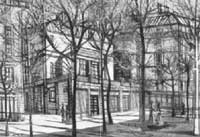| |
Jean Carzou 让卡尔祖
1907 On January 1st, Karnik Zouloumian was born in ALEP in Syria, of Armenian parents.They had left Armenia because their families disapproved of their union. He was only ten when his father, a photographer, died. After that, he left Syria with his mother and sister, to settle in Egypt
where his
mother's family lived.
He was a bright student at the Armenian Lycee
in Cairo.
1924 He obtained an American scholarship (Yeghiayan Foundation), to go and study in Paris at the "École Spéciale
d’Architecture".
1929 He graduated in. He often went to the Louvre where Ingres' paintings inspired him to become a painter
As an autodidact, he enrolled himself in the
Montparnasse Art Academy (La Grande Chaumière) and decided to give himself up exclusively to painting.
First, he directed his work towards geometrical abstraction, he approched Surrealism, but very quickly,
he developed his own style:figurative representation with elements of oneirism. His meeting with Gabriel Boissy, was to allow him access to Comoedia, where he illustrated fairy tales and short stories. Later, in order to earn
a living, he produced caricatures of politicians in newspapers, such as Hitler,
represented as a "German
Father Christmas" in "Aux écoutes" n° 814 on December 23rd 1933.
1930 His first exhibition was at the "Salon des Indépendants".
1936 He married Jeanne Blanc, "a Provencal classical Beauty, with sweet eyes, with whom he knew the joy
of living " as she was described by Florent Fels.
Painting, music, literature and politics were at the heart of their life. Nane Carzou wrote some books which the artist illustrated.
When war was declared , they found refuge in Prades, then in Burgundy where he was to discover country life.
The War was to inspire him with the fantastic elements in his work.
1938 Birth of his son: Jean-Marie. He always remained close to his parents, as can be seen in the narration
of their journey in Armenia. Among other things, he wrote a preface to the catalogue of the exhibition "Figures rituelles", at the new Gallery Emmanuel David and whole heartedly supported the
cause of Armenia.
1939 Carzou's success started when he took part in the contest-exhibition organized by "Pour que l’Esprit vive" with his painting "Saint François d'Assise" which obtained second prize. He confirmed his status with his first
private exhibition, galerie Contemporaine, rue de Seine.
He went on to organize over one hundred private exhibitions of his works in Paris, in the provinces and abroad.
He regularly took part in Salons des Indépendants, d’Automne, des
Tuileries,
and various Art Exhibitions of groups, and in numerous exhibitions regional and worldwide. He was awarded the Hallmark prize three times: in 1949 with his painting "Le berger et les mages" (The shepherd and the Mage) in 1951 and in 1955. He obtained le grand prix de l’Ile de France in 1954 with "Château abandonné à Bougival" (derelict castle at Bougival).Then le
grand prix
de l‘Éducation nationale in Tokyo, ein 1955
and le grand prix "Europe" at the first Bienniale in Bruges, in 1958.
| |

|
|
|
Michel Nau : First Poets Festival - Hébertot Theatre- Jean Carzou
|
1952 Carzou confirmed his public fame in the theatrical world with his sets and costumes of Incas for "les Indes Galantes" by Rameau.
He worked six more times for the stage. He created the settings and costumes of "wolf" from J.Anouilh and G. Neveu,for Roland Petit's Ballets, (1953); those of "Giselle" (1954) for the
Opera de Paris; and those of "Athalie" (1955) for the theatre la Comédie-Française.
" Le Loup" (The Wolf) by J. Anouilh and G. Neveu was be produced again by La Scala de Milan (1963).
Carzou again worked with the performing arts with "After Eden" (1966)
for an American Company, Harkness ballets; then with "Jeanne et ses juges" (Joan and her judges) from Thierry Maulnier (1968) at Mai de Versailles
and lastly "la Périchole" for the
theatre de Paris (1969),
where his stage-sets and costumes had world wide success . On the occasion of the performance of "La Perichole" (1975), the theatre of Angers organized
an exhibition of his complete stage-work.
1953 Le salon des Peintres Témoins de leur Temps (The Art Exhibition of his Painters Witness of their Days)organized a referendum by the public to find out which painting the visitors would like to possess: "la promenade des amants" (The Lover's Walk) by Carzou, took the biggest number of
votes. Two years
later, he was named one of the "Ten Best Painters" of the Post-War génération
Connaissance des Arts.
His two exhibiitions, at the gallery David et Garnier: Venise 1953, totally dedicated to Venice and Apocalypse 1957, inspired by Modern Times, (completed during the previous year and the three Summer months spent in the calm of Bourbonnais, at Mayet de Montagne), was very well received.
The water-colours exhibition Escales had the same success.
1959 Carzou went to the U.S.A.for the opening of his first exhibiition in New-York, at the Wildenstein gallery.
1960 Provence where he often stayed was used as the theme for his Provence exhibiition at David and Garnier's.Throughout the sixties and seventies his fame grew. All
over the world,
exhibitions were organized,
of his engraved work.
He undertook the illustration (water-colours lithographs, etchings, dry-point etchings) of many authors: A.Arnoux, J. Audiberti,A. Camus,T.S. Eliot, J. Follain, E.
Hemingway, J. Gracq, E. Ionesco, Ch. Kunstler,
P. Mac Orlan, F. Mauriac, A. Maurois, E. Poe, A. Pollier, A. Rimbaud, W. Skakespeare, A. Verdet, J. Verne,
A. Vidalie…
1962 For the first time in Paris, his painted ceramics were exhibited , alongside his watercolours, drawings and lithographies.
In the same year, Pierre Cailler published the descriptive catalogue of Carzou's engraving and lithography work.
Abroad, the exhibitions followed one after another, as well as the journeys to Japan, Lebanon, Sweden, Switzerland and the U.S.A. (2nd journey in 1972). Carzou went to Armenia three times with breaks in Russia (1966, 1969 and 1984 where he was given the decoration "Mardiros Sarian" at Erevan).
As an artist he used different media: he produced sculptures, (especially "The Bust" 1978), ceramics, menus
and a painting called
"Parc de l'Ile de France" for the liner "France" ; tapestry patterns :"L’invitation au voyage "
(a journey invitation), for the Manufacture des Gobelins; a tapestry inspied
by "la Périchole" for "le mur du Nomade" (the Nomad wall); and for Pierre de Tartas, two other tapestry cartoons. He also took part in the international prize of gemmail in Tours and he was nominated "New Painter of the light" with "Fille de Carthage"* (A
girl from Carthagenia)
1976 Carzou took part in the Cannes Festival as a Membre of the selection committee. In the same year,
the Post-office published a Carzou stamp "Princesse
lointaine" (Distant Princess) and
the Post-office Museum presented an important exhibition of his works (paintings, drawings and lithographies).
He created a line of lithographies for "le château d’Argol" from Julien Gracq, commissioned by the Société des Bibliophiles de l’Automobile Club de France.
1977 Numerous retrospectives of his works have been organized: at the château de Val in Corrèze, under the patronage of President Jacques Chirac, at Rochechouart, at the château des Hayes, at Perouges, near Lyon;
in Switzerland and Luxemburg.
He was promoted to the rank of Commandeur de l’Ordre du Mérite by the President de la République and elected
at the Académie des Beaux-Arts (Art Academy) on december 7th 1977, in the seat of deceased Jean Bouchaud.
1979 On April 4 th, he was presented to the Academy by M. Emmanuel Bondeville, its lifelong secretary.
In his speech, he contested cubism "Picasso is not a painter" and modernity in general. He prefered Claude Lorrain,
Watteau and Dali, though enjoying buying works of his figuratve contemporaries, especially those
by Maurice Boitel, at the René Drouet gallery, faubourg Saint-Honoré.
1981 The château de Vascoeuil organized a Carzou retrospective with presentation of stage-sets and costumes of "la Périchole" during the three Summer months.
He lived in Vence from 1958 onwards, and he spent many summers and other times in his home,on the avenue
Jean Maurel, in the Ara region. There, according to Chave the gallery owner who he worked with as a lithographer "he would have: meals at the "la Farigoule" or purchase paint-brushes or pencils and other drawing-paper at 13
rue Isnard" That is how he was named "citoyen d’honneur de la ville ",
(honorable citizen of the City) and the Mayor, Bernard Demichelis voted for the creation of a "musée Carzou" inside the Emile Hugues Foundation, in the château de Villeneuve .
1982 Official delivery, in the Hall of the Comtesse de Caen, at the Institut, of his Academician sword, which
he designed and was a gift
from his friends and admirers.
1985 At the age of 78, Carzou undertook a gigantic Apocalypse to decorate the chapel of the Congregation
des Dames de la Présentation at Manosque;a blue-green fresco,over six hundred and sixty-six square meters long,representing "the cycle of human adventure" such as he defined it. He shows his horror of war, genocides,
holocaustes through the devastated
landscapes,
palaces in ruins, blockhaus and numerous intricated rails,
which can be found in this work. His fear of an over-undustrialised world is illustrated by four supersonic jets,
messengers of future catastrophies. But an embracing couple gives us hope again; the Earth will be reborn
as symbolized by this woman-tree of the last painting, "l'accomplissement".
1986 Preparations for the opening of "Carzou Museum", in Vence, the town to which Jean Carzou made
a donation of 43 oil-paintings, several of them of a large size, 52 paintings in poster paint, water-colours, drawings, all his engraving and lithographed work, sculptures, ceramics,illustrated books, theatre stage-settings
models
and costumes. This gave a complete
panorama of the artist, from his beginnings. François Léotard, the minister
of Culture, opened the exhibition on July 13th 1986.
1988 The Francony Gallery presented Carzou 's work of the years 30-40, revealing to the public, his role as
a precursor as well as the continuity in his work.
1990 A contoversial legal battle took place and "le musée Carzou" closed its doors.
The works were given back to the artist.
1991 The church of the convent of Manosque in which he had decorated the chapel became Carzou
Foundation
1995 The mayor of Dinard offered to house Carzou's donation in a museum named after him; the château de Port-Breton (former residence of the industrialist Boussac) was chosen but the project came to nothing.
1997 The town of Le Cannet organized a retrospective at Bonnard Place.
1998 In march, his wife Nane died. Then he retired to his son Jean-Marie etand his daughter-in-law's home
at Saint-Aquilin.
2000 Officer of the Legion of honour, Commander of the Order of Merit and Commander of the Arts and Letters,
at the age of 93, he died on August 12th at PERIGUEUX (Dordogne)
2003 26.11 Reception of Zao Wou-Ki elected as a member of the painting section, taking the place of Jean Carzou, in the Institute of France, Academy of Arts.
* " Fille de Carthage " can be seen in the article " Gemmail " in Know +
D.Sicard
Multiple Sources: Like every synthesis, this biography only exists, thanks to the work of specialists that can be found in the books and catalogues indexed in the bibliography of this site.
|

